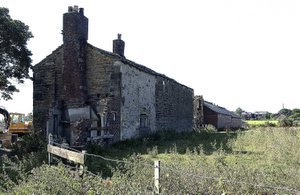 This is Bradford
This is Bradford and
Leeds Today publish how Thornbush Farm, the house in which
the Reverend Patrick Bronte lodged at the three-bedroom cottage while a curate at Hartshead church between 1811 and 1815.
Quoting Dudley Green's Letters of the Reverend Patrick Brontë
:
In March 1811, Patrick took up the appointment of Perpetual Curate of St. Peter's Hartshead. Although the parish of Hartshead-cum-Clifton lay within the parish of Dewsbury, this appointment represented his first independent living. Withing a year of his arrival growing industrial unrest broke out into the Luddite riots. These were centred on Patrick's parish and culminated in the attack on Rawfold's Mill near Cleckheaton, on the night of 11 April 1812. While Patrick was opposed to any acts of violence against property, he is said to have had a personal sympathy for rioters seeking to bury their death under cover of night. During his time at Harthsead Patrick saw the publication of his first literary work: Cottage Poems, intended as a form of education of the poor. In July 1812 he was invited by John Fennell, the headmaster of Woodhouse Grove School, Rawdon (a newly founded school for the sons of Methodist ministers), to examine the boys on Classics. While he was at the school he met Maria Branwell, the headmaster's niece, who had come from Penzance to help her uncle and aunt on the domestic side. Patrick and Maria rapidly fell in love and they were married on 19 December 1812. Their two eldest daughters were born in Hartshead, Maria (January 1814) and Elizabeth (8 February 1815).As the church didn't have a Parsonage-House, Patrick was on lodgings. From September 1812, he was at Lousy Farm, just opposite the church. Lousy Farm now is known as Thornbush Farm. Later he move to Clough House, on the same road as the farm. In the Brontë Gazette (September 2004), Imelda Marsden was asking for help as the house was in serious danger:
“Last year Lousy Farm just off Buttershaw Lane in Liversedge, was put up for sale. I hear on the grapevine that its owner had demolition in mind. A temporary preservation order was placed on it after I had contacted my local MP, Mike Wood, who contacted English Heritage. It turns out that we cannot get it listed on the building, but of course we are trying to do it on the history. Patrick used it as lodgings when he came as curate to St Peter’s Church, Hartshead in 1811. He wrote his Cottage Poems while staying there, and groups of Luddites passed it.”
But now the story seems to have a happy ending:
Mrs Marsden said: "We have had letters sent in support of our campaign from Bronte Society members and academics from all over the world.
"We are thrilled that we have succeeded."
Mrs Marsden, of Mirfield, and formerly the Bronte Society's heritage conservation spokesman, said she understood Patrick Bronte had brought his wife, Maria, to the house, after their marriage in Guiseley.
It is believed Patrick also witnessed skirmishes involving Luddite rebels and wrote some of his cottage poems', a collection of moral verse, while staying at the farm.
Patrick and his bride moved to a house in Market Street, Thornton, soon after their marriage and this was where Charlotte, Branwell, Emily and Anne were born.
Stan Driver, Kirklees Council's principal planning and conservation officer, said Thornbush Farm had been put forward for listing because of its "literary, architectural and historical" interest.
He said: "We were happy to submit a request for listing after being contacted by the Bronte Society."
Bronte Parsonage Museum director Alan Bentley said: "I think it is important to preserve buildings which are a part of the Bronte heritage.
"Patrick lived there before the Bronte sisters were born but it was an important period in his life as he was involved with Luddite rebels. He told Charlotte about this and similar events appeared in her novel Shirley."
An English Heritage spokesman said representatives had visited the farm and had been impressed by the structure and its literary and historical connections.
Mrs Marsden said she hoped the building would be included in Bronte heritage tours in the near future.EDIT:
IcHuddersfield also covers the story.
The farm has been given Grade II listed status from English Heritage, working for the Government's Department for Culture, Media and Sport.
Listed buildings are judged to have special architectural, historical or cultural significance. They may not be demolished, extended or altered without special permission from the local planning authority.
The campaign for listing Thornbush Farm was led by Mirfield woman Imelda Marsden, who is a social historian and a member of the Bronte Society.
She said: "I can't believe they granted listed status. It's great news.
"It is privately owned and I wanted to get it listed when I heard that it might be sold and demolished, because it is dilapidated.
Categories: Brontëana, Patrick_Brontë, Cottage_Poems





Well done Imelda ! Bravo ! Your tenacity is worthy of the excellent results. Nevertheless the sentence: “ A ‘temporary ‘ preservation order “ , leaves in someway a doubt; personally do really hope that it may, quite soon, be changed into a reassuring ‘definitive ‘.
ReplyDeleteBronte’s world must be saved, for worldly common cultural interest !- Mrs. Marsden my foreign-member’s solidarity is totally with you and the BBS. Best compliments.-
We also hope that temporary becomes permanent. Brontë heritage should be preserved so that we go on pilgrimages. Good job, Imelda.
ReplyDelete